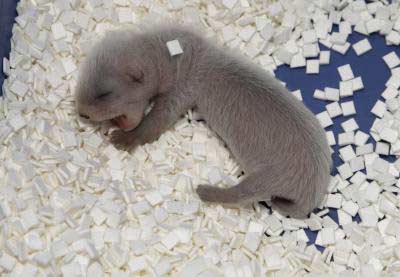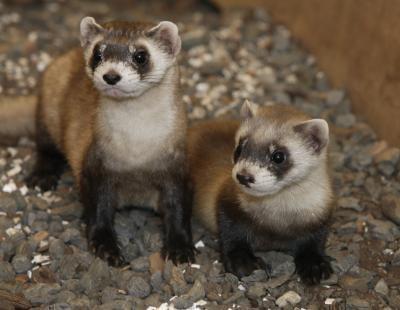Black-footed ferrets are born from frozen sperm
The two black-footed ferrets at the Smithsonian National Zoo gave birth to two babies fertilized by males who died in 1999 and 2000. Weasels are on the brink of extinction - included in the conservation and inducing affiliate program. varieties of many organs and organizations - artificial insemination in May with frozen sperm of two dead males.
Sperm samples were collected and frozen in 1997 and 1998. Successful artificial insemination with frozen sperm is rare - only three black-footed ferrets have so far been born from this method.
Black-footed ferret is one of the world's most endangered species. They used to live in the grasslands of the West Great Plains. The number of black-footed ferrets decreases with the narrow North American grassland ecosystem. Pasture dogs are the main prey of this weasel, and currently only about 2% of the habitat of pasture dogs exists. The recent outbreak of plague in grassland dogs in South Dakota also threatens black-footed ferrets.

2-week-old black-footed ferret at the National Zoo's Research and Conservation Center at Front Royal, Va.July 3, 2008. Weasel was born on June 21, the work of a 2-year-old mother-in-law and a ferret father who died in 2000. Scientists at the national zoo have artificially fertilized their children. Cold sperm sperm of a male in a gene bank - where sperm and eggs are stored in many endangered animals.(Photo: Mehgan Murphy, Smithsonian National Zoo)
For more than 10 years, sperm samples were stored at the Zoo's Genebank, which contains the frozen sperm of the best males.In animals with short life cycles such as black-footed ferrets, cold storage, or freezing, sperm expand the ability of each individual to breed. The bank has a mission to preserve and even enhance genetic diversity by adding new genes. A healthy and genetically diverse community of organisms has a greater chance of survival in the wild. The bank also plays a role in protecting against environmental events, such as outbreaks of disease.

Two-month-old black-footed ferret (right) with mother-in-law at the National Zoo's Conservation and Research Center at Front Royal, Va.August 18, 2008. Mother's weasel gave birth to a weasel on June 21 after being artificially inseminated with a male sperm frozen in 1998. Successful artificial insemination with eastern sperm Cold is very rare - so far only 3 black-footed ferrets have been born from this method.(Photo: Jessie Cohen, Smithsonian National Zoo).
The national zoo has played a crucial role in restoring black-footed ferrets since 1981 when a small group of these animals, thought to be extinct, was discovered in Wyoming. The remaining 18 black-footed ferrets were removed from the wild to build breeding and restoration programs in Wyoming. National Zoo Conservation Research Center at Front Royal, Va. was the first facility outside Wyoming to breed this animal. Scientists at the National Zoo have successfully performed artificial insemination for this animal by directly inserting sperm into the uterus.
The national zoo's black-footed ferret program is closely linked to the US Marine and Wildlife Service and the Black-footed Weasel Restoration Project, to breed and then restore this animal in the area. The area is protected in South Dakota, Wyoming, Montana, Mexico, Colorado, Utah and Arizona. From 1989 to 2007, more than 500 black-footed ferrets were born at the National Zoo's Research and Conservation Center at Front Royal, Va. with more than 380 episodes of natural breeding, and 130 were born from artificial insemination with fresh sperm. From the original 18 black-footed ferrets, there are now over 700 living in the wild environment.
- Create pandas from frozen sperm
- Twins are born more than 2 years apart
- The first American baby was born from frozen sperm and eggs
- Future sperm bank on the Moon
- Twins due to frozen sperm for 26 years
- Frozen sperm can live in space
- Can you believe this is the world's most dangerous cat?
- It turns out that it is the egg that determines which sperm to choose to conceive
- Dogs born from frozen embryos
- Create baby elephants from frozen sperm
- Amazing baby born from a frozen embryo 14 years ago
- Medical record: baby born from cold embryos 20 years
 Animal 'suffering' after hibernation
Animal 'suffering' after hibernation Why do goats climb well?
Why do goats climb well? Scientists were surprised to see chimpanzees eating turtles
Scientists were surprised to see chimpanzees eating turtles Giant catfish died deadly due to drought in Thailand
Giant catfish died deadly due to drought in Thailand